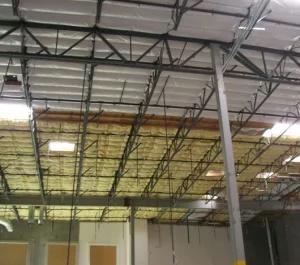In the realm of warehouse management, optimizing energy efficiency and maintaining a comfortable working environment are paramount. One often-overlooked aspect of achieving these goals is proper insulation for warehouse ceiling. In this comprehensive guide, we’ll delve into the importance of insulation for warehouse ceilings and explore various solutions to enhance energy efficiency and thermal comfort.

Understanding Insulation for Warehouse Ceiling
Why Insulation Matters
Insulating the ceiling of a warehouse serves multiple purposes, including:
- Temperature Regulation: Proper insulation helps maintain consistent indoor temperatures, reducing the need for excessive heating or cooling and consequently lowering energy costs.
- Condensation Control: Insulation can prevent condensation buildup on the ceiling, which can lead to moisture-related issues such as mold growth and structural damage.
- Noise Reduction: Insulation materials can absorb sound waves, minimizing noise pollution within the warehouse environment and improving overall acoustic comfort.
Types of Insulation Materials
1. Fiberglass Insulation
Fiberglass insulation, composed of fine glass fibers, is a popular choice for warehouse ceilings due to its affordability and effectiveness in thermal insulation.
2. Foam Board Insulation
Foam board insulation, made from rigid foam panels, offers excellent thermal resistance and moisture resistance, making it suitable for warehouse applications.
3. Spray Foam Insulation
Spray foam insulation expands upon application, filling gaps and crevices to create a seamless thermal barrier. It provides superior insulation performance but may require professional installation.
Factors to Consider When Choosing Insulation
1. R-Value
The R-value indicates the thermal resistance of insulation material. Higher R-values offer better insulation performance, so consider the climate and desired level of insulation when selecting materials.
2. Fire Resistance
Ensure that the chosen insulation materials comply with fire safety regulations to minimize the risk of fire hazards in the warehouse.
3. Installation Method
Consider the ease of installation and whether professional assistance is required, especially for complex insulation projects or hard-to-reach areas.
Installation Process
1. Preparation
Before installation, ensure that the ceiling surface is clean and free of debris. Address any existing moisture or structural issues to prevent future complications.
2. Application
Follow the manufacturer’s instructions for the chosen insulation material. Install the insulation evenly and securely to maximize its effectiveness.
3. Sealing
Seal any gaps or seams in the insulation to prevent air leakage and ensure optimal thermal performance.
Read too: Discovering the Charm of Nautical Outdoor Ceiling Fans for Your Coastal Retreat: Sail into Style
Conclusion
Proper insulation for warehouse ceilings is essential for maintaining energy efficiency, thermal comfort, and structural integrity. By understanding the importance of insulation and selecting the appropriate materials and installation methods, warehouse managers can create an optimized indoor environment conducive to productivity and employee well-being.